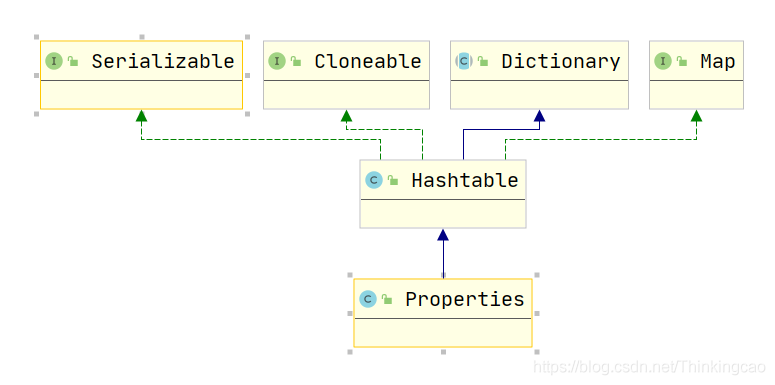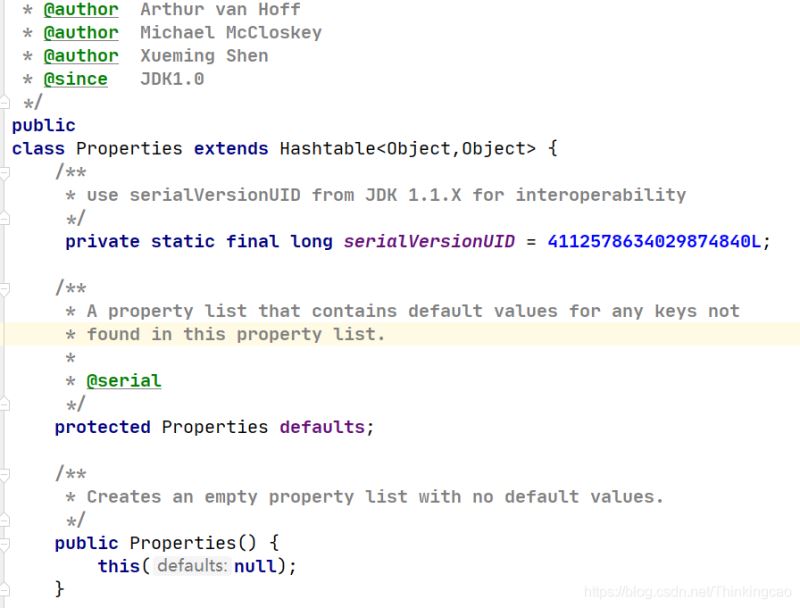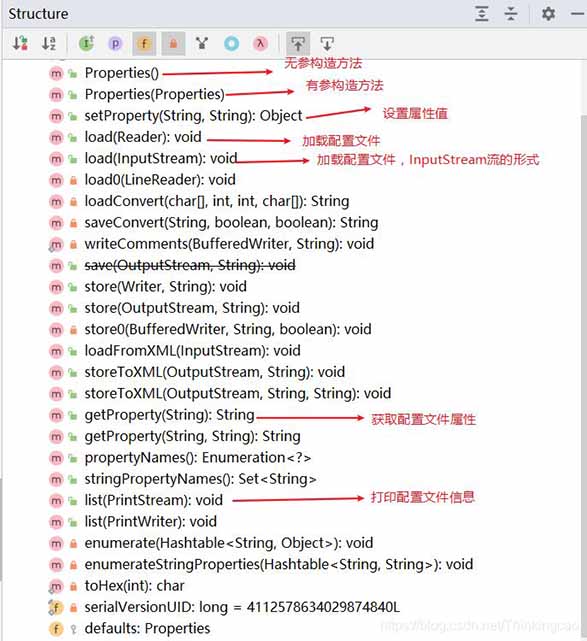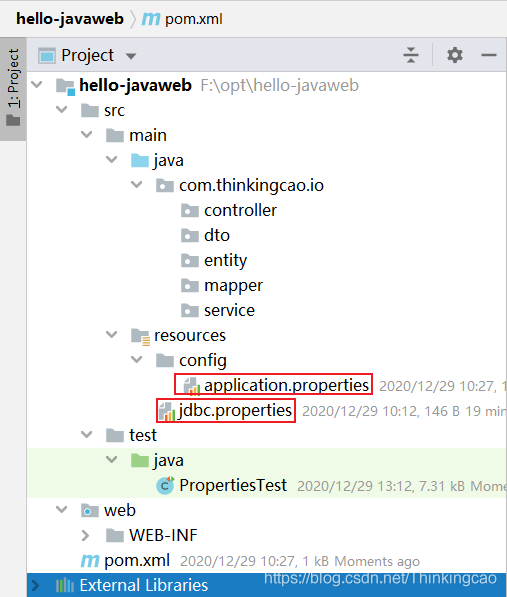Java读取properties配置文件的8种方式汇总
一、前言
在做Java项目开发过程中,涉及到一些数据库服务连接配置、缓存服务器连接配置等,通常情况下我们会将这些不太变动的配置信息存储在以 .properties 结尾的配置文件中。当对应的服务器地址或者账号密码信息有所变动时,我们只需要修改一下配置文件中的信息即可。同时为了让Java程序可以读取 .properties配置文件中的值,Java的JDK中提供了java.util.Properties类可以实现读取配置文件。
二、Properties类
Properties 类位于 java.util.Properties中,是Java 语言的处理配置文件所使用的类,其中的xxx.Properties类主要用于集中的持久存储Java的配置文件内容,可以读取后缀是.properties和.cfg的配置文件。
Properties继承了Hashtable 类,以Map 的形式进行放置值,put(key,value) 和 get(key),文本注释信息可以用"#"来注释。
Properties 类表示了一个持久的属性集。Properties 可保存在流中或从流中加载。属性列表中每个键及其对应值都是一个字符串。
Properties 文件内容的格式是:键=值 形式,Key值不能够重复。 例如:
jdbc.driver=com.mysql.jdbc.Driver
Properties类的继承关系图:

Properties类的源码关系图:

主要方法介绍:

它提供了几个核心的方法:
- getProperty ( String key): 用指定的键在此属性列表中搜索属性。也就是通过参数 key ,得到 key 所对应的 value。
- load ( InputStream inStream): 从输入流中读取属性列表(键和元素对)。通过对指定的文件(比如说上面的 test.properties 文件)进行装载来获取该文件中的所有键 - 值对。以供 getProperty ( String key) 来搜索。
- setProperty ( String key, String value) : 调用 Hashtable 的方法 put 。他通过调用基类的put方法来设置 键 - 值对。
- store ( OutputStream out, String comments): 以适合使用 load 方法加载到 Properties 表中的格式,将此 Properties 表中的属性列表(键和元素对)写入输出流。与 load 方法相反,该方法将键 - 值对写入到指定的文件中去。
- clear (): 清除所有装载的 键 - 值对。该方法在基类中提供。
三、Properties常用方法实践
Properties类我们从文件的写入和读取来实践其具体用法,下面演示练习将以下数据库配置信息写入到jdbc.properties文件中
jdbc.driver=com.mysql.jdbc.Driver jdbc.url=jdbc:mysql://localhost:3306/mybatis?characterEncoding=utf8 jdbc.username=root jdbc.password=123456
项目目录结构如下

四、Java写入Properties
Properties类调用setProperty方法将键值对保存到内存中,此时可以通过getProperty方法读取,propertyNames方法进行遍历,但是并没有将键值对持久化到属性文件中,故需要调用store方法持久化键值对到属性文件中。
import java.io.FileOutputStream;
import java.io.IOException;
import java.io.OutputStream;
import java.util.Properties;
/**
* @desc: 写入Mysql数据库了连接信息到jdbc.properties中
* @author: cao_wencao
* @date: 2020-12-29 13:41
*/
public class PropertiesStoreTest {
public static void main(String[] args) {
Properties properties = new Properties();
OutputStream output = null;
try {
output = new FileOutputStream("src/main/resources/jdbc.properties");
properties.setProperty("jdbc.driver", "com.mysql.jdbc.Driver");
properties.setProperty("jdbc.url","jdbc:mysql://localhost:3306/mybatis?characterEncoding=utf8" );
properties.setProperty("jdbc.username", "root");
properties.setProperty("jdbc.password", "123456");
// 保存键值对到文件中
properties.store(output, "Thinkingcao modify");
} catch (IOException io) {
io.printStackTrace();
} finally {
if (output != null) {
try {
output.close();
} catch (IOException e) {
e.printStackTrace();
}
}
}
}
}
输出结果,在resources目录下多一个文件jdbc.properties,内容如下:
#Thinkingcao modify #Tue Dec 29 13:43:48 CST 2020 jdbc.url=jdbc\:mysql\://localhost\:3306/mybatis?characterEncoding\=utf8 jdbc.username=root jdbc.driver=com.mysql.jdbc.Driver jdbc.password=123456
五、Java读取Properties
Java读取Properties文件的方法有很多,下面介绍8种方式,分别读取resource目录下的jdbc.properties和resource/config/application.properties。
application.properties文件内容如下
minio.endpoint=http://localhost:9000 minio.accessKey=minioadmin minio.secretKey=minioadmin minio.bucketName=demo
1. 从当前的类加载器的getResourcesAsStream来获取
/**
* 1. 方式一
* 从当前的类加载器的getResourcesAsStream来获取
* InputStream inputStream = this.getClass().getResourceAsStream(name)
*
* @throws IOException
*/
@Test
public void test1() throws IOException {
InputStream inputStream = this.getClass().getResourceAsStream("jdbc.properties");
Properties properties = new Properties();
properties.load(inputStream);
properties.list(System.out);
System.out.println("==============================================");
String property = properties.getProperty("jdbc.url");
System.out.println("property = " + property);
}
2. 从当前的类加载器的getClassLoader().getResourcesAsStream来获取
/**
* 2. 方式二
* 从当前的类加载器的getResourcesAsStream来获取
* InputStream inputStream = this.getClass().getClassLoader().getResourceAsStream(name)
*
* @throws IOException
*/
@Test
public void test2() throws IOException {
InputStream inputStream = this.getClass().getClassLoader().getResourceAsStream("config/application.properties");
Properties properties = new Properties();
properties.load(inputStream);
properties.list(System.out);
System.out.println("==============================================");
String property = properties.getProperty("minio.endpoint");
System.out.println("property = " + property);
}
3. 使用Class类的getSystemResourceAsStream静态方法 和使用当前类的ClassLoader是一样的
/**
* 3. 方式三
* 使用Class类的getSystemResourceAsStream方法 和使用当前类的ClassLoader是一样的
* InputStream inputStream = ClassLoader.getSystemResourceAsStream(name)
*
* @throws IOException
*/
@Test
public void test3() throws IOException {
InputStream inputStream = ClassLoader.getSystemResourceAsStream("config/application.properties");
Properties properties = new Properties();
properties.load(inputStream);
properties.list(System.out);
System.out.println("==============================================");
String property = properties.getProperty("minio.endpoint");
System.out.println("property = " + property);
}
4. 使用Spring-core包中的ClassPathResource读取
/**
* 4. 方式四
* Resource resource = new ClassPathResource(path)
*
* @throws IOException
*/
@Test
public void test4() throws IOException {
Resource resource = new ClassPathResource("config/application.properties");
Properties properties = PropertiesLoaderUtils.loadProperties(resource);
properties.list(System.out);
System.out.println("==============================================");
String property = properties.getProperty("minio.endpoint");
System.out.println("property = " + property);
}
5. 从文件中读取,new BufferedInputStream(InputStream in)
/**
* 5. 方式五
* 从文件中获取,使用InputStream字节,主要是需要加上当前配置文件所在的项目src目录地址。路径配置需要精确到绝对地址级别
* BufferedInputStream继承自InputStream
* InputStream inputStream = new BufferedInputStream(new FileInputStream(name)
* 这种方法读取需要完整的路径,优点是可以读取任意路径下的文件,缺点是不太灵活
* @throws IOException
*/
@Test
public void test5() throws IOException {
InputStream inputStream = new BufferedInputStream(new FileInputStream("src/main/resources/config/application.properties"));
Properties properties = new Properties();
properties.load(inputStream);
properties.list(System.out);
System.out.println("==============================================");
String property = properties.getProperty("minio.endpoint");
System.out.println("property = " + property);
}
6.从文件中读取,new FileInputStream(String name)
/**
* 6. 方式六
* 从文件中获取,使用InputStream字节,主要是需要加上当前配置文件所在的项目src目录地址。路径配置需要精确到绝对地址级别
* FileInputStream继承自InputStream
* InputStream inputStream = new FileInputStream(name)
* 这种方法读取需要完整的路径,优点是可以读取任意路径下的文件,缺点是不太灵活
* @throws IOException
*/
@Test
public void test6() throws IOException {
InputStream inputStream = new FileInputStream("src/main/resources/config/application.properties");
Properties properties = new Properties();
properties.load(inputStream);
properties.list(System.out);
System.out.println("==============================================");
String property = properties.getProperty("minio.endpoint");
System.out.println("property = " + property);
}
7. 使用PropertyResourceBundle读取InputStream流
/**
* 7. 方式七
* 使用InputStream流来进行操作ResourceBundle,获取流的方式由以上几种。
* ResourceBundle resourceBundle = new PropertyResourceBundle(inputStream);
* @throws IOException
*/
@Test
public void test7() throws IOException {
InputStream inputStream = ClassLoader.getSystemResourceAsStream("config/application.properties");
ResourceBundle resourceBundle = new PropertyResourceBundle(inputStream);
Enumeration<String> keys = resourceBundle.getKeys();
while (keys.hasMoreElements()) {
String s = keys.nextElement();
System.out.println(s + " = " + resourceBundle.getString(s));
}
}
8. 使用ResourceBundle.getBundle读取
/**
* 8. 方式八
* ResourceBundle.getBundle的路径访问和 Class.getClassLoader.getResourceAsStream类似,默认从根目录下读取,也可以读取resources目录下的文件
* ResourceBundle rb = ResourceBundle.getBundle("b") //不需要指定文件名的后缀,只需要写文件名前缀即可
*/
@Test
public void test8(){
//ResourceBundle rb = ResourceBundle.getBundle("jdbc"); //读取resources目录下的jdbc.properties
ResourceBundle rb2 = ResourceBundle.getBundle("config/application");//读取resources/config目录下的application.properties
for(String key : rb2.keySet()){
String value = rb2.getString(key);
System.out.println(key + ":" + value);
}
}
输出结果:
minio.endpoint:http://localhost:9000
minio.bucketName:demo
minio.secretKey:minioadmin
minio.accessKey:minioadmin
六、Properties配合Spring框架使用
加载.properties方式一
<!-- 1.加载 jdbc.properties 配置文件 --> <context:property-placeholder location="classpath:jdbc.properties" system-properties-mode="NEVER"/>
除了上面这种方式之外,还有下面这种List集合的方式
加载.properties方式二
<!-- 4.引入外部配置文件 由于后期可能会引入多个配置文件 所以采用list的形式 -->
<bean id="propertyPlaceholder"
class="org.springframework.beans.factory.config.PropertyPlaceholderConfigurer">
<property name="locations">
<list>
<value>classpath:/config/jdbc.properties</value>
<value>classpath:/config/application.properties</value>
</list>
</property>
</bean>
七、完整代码
import org.junit.Test;
import org.springframework.core.io.ClassPathResource;
import org.springframework.core.io.Resource;
import org.springframework.core.io.support.PropertiesLoaderUtils;
import java.io.BufferedInputStream;
import java.io.FileInputStream;
import java.io.IOException;
import java.io.InputStream;
import java.util.*;
/**
* @desc: Properties读取配置文件属性值的方式
* @author: cao_wencao
* @date: 2020-12-29 10:08
*/
public class PropertiesTest {
/**
* 1. 方式一
* 从当前的类加载器的getResourcesAsStream来获取
* InputStream inputStream = this.getClass().getResourceAsStream(name)
*
* @throws IOException
*/
@Test
public void test1() throws IOException {
InputStream inputStream = this.getClass().getResourceAsStream("jdbc.properties");
Properties properties = new Properties();
properties.load(inputStream);
properties.list(System.out);
System.out.println("==============================================");
String property = properties.getProperty("jdbc.url");
System.out.println("property = " + property);
}
/**
* 2. 方式二
* 从当前的类加载器的getResourcesAsStream来获取
* InputStream inputStream = this.getClass().getClassLoader().getResourceAsStream(name)
*
* @throws IOException
*/
@Test
public void test5() throws IOException {
InputStream inputStream = this.getClass().getClassLoader().getResourceAsStream("config/application.properties");
Properties properties = new Properties();
properties.load(inputStream);
properties.list(System.out);
System.out.println("==============================================");
String property = properties.getProperty("minio.endpoint");
System.out.println("property = " + property);
}
/**
* 3. 方式三
* 使用Class类的getSystemResourceAsStream方法 和使用当前类的ClassLoader是一样的
* InputStream inputStream = ClassLoader.getSystemResourceAsStream(name)
*
* @throws IOException
*/
@Test
public void test4() throws IOException {
InputStream inputStream = ClassLoader.getSystemResourceAsStream("config/application.properties");
Properties properties = new Properties();
properties.load(inputStream);
properties.list(System.out);
System.out.println("==============================================");
String property = properties.getProperty("minio.endpoint");
System.out.println("property = " + property);
}
/**
* 4. 方式四
* Resource resource = new ClassPathResource(path)
*
* @throws IOException
*/
@Test
public void test2() throws IOException {
Resource resource = new ClassPathResource("config/application.properties");
Properties properties = PropertiesLoaderUtils.loadProperties(resource);
properties.list(System.out);
System.out.println("==============================================");
String property = properties.getProperty("minio.endpoint");
System.out.println("property = " + property);
}
/**
* 5. 方式五
* 从文件中获取,使用InputStream字节,主要是需要加上当前配置文件所在的项目src目录地址。路径配置需要精确到绝对地址级别
* BufferedInputStream继承自InputStream
* InputStream inputStream = new BufferedInputStream(new FileInputStream(name)
* 这种方法读取需要完整的路径,优点是可以读取任意路径下的文件,缺点是不太灵活
* @throws IOException
*/
@Test
public void test3() throws IOException {
InputStream inputStream = new BufferedInputStream(new FileInputStream("src/main/resources/config/application.properties"));
Properties properties = new Properties();
properties.load(inputStream);
properties.list(System.out);
System.out.println("==============================================");
String property = properties.getProperty("minio.endpoint");
System.out.println("property = " + property);
}
/**
* 6. 方式六
* 从文件中获取,使用InputStream字节,主要是需要加上当前配置文件所在的项目src目录地址。路径配置需要精确到绝对地址级别
* FileInputStream继承自InputStream
* InputStream inputStream = new FileInputStream(name)
* 这种方法读取需要完整的路径,优点是可以读取任意路径下的文件,缺点是不太灵活
* @throws IOException
*/
@Test
public void test6() throws IOException {
InputStream inputStream = new FileInputStream("src/main/resources/config/application.properties");
Properties properties = new Properties();
properties.load(inputStream);
properties.list(System.out);
System.out.println("==============================================");
String property = properties.getProperty("minio.endpoint");
System.out.println("property = " + property);
}
/**
* 7. 方式七
* 使用InputStream流来进行操作ResourceBundle,获取流的方式由以上几种。
* ResourceBundle resourceBundle = new PropertyResourceBundle(inputStream);
* @throws IOException
*/
@Test
public void test7() throws IOException {
InputStream inputStream = ClassLoader.getSystemResourceAsStream("config/application.properties");
ResourceBundle resourceBundle = new PropertyResourceBundle(inputStream);
Enumeration<String> keys = resourceBundle.getKeys();
while (keys.hasMoreElements()) {
String s = keys.nextElement();
System.out.println(s + " = " + resourceBundle.getString(s));
}
}
/**
* 8. 方式八
* ResourceBundle.getBundle的路径访问和 Class.getClassLoader.getResourceAsStream类似,默认从根目录下读取,也可以读取resources目录下的文件
* ResourceBundle rb = ResourceBundle.getBundle("b") //不需要指定文件名的后缀,只需要写文件名前缀即可
*/
@Test
public void test8(){
//ResourceBundle rb = ResourceBundle.getBundle("jdbc"); //读取resources目录下的jdbc.properties
ResourceBundle rb2 = ResourceBundle.getBundle("config/application");//读取resources/config目录下的application.properties
for(String key : rb2.keySet()){
String value = rb2.getString(key);
System.out.println(key + ":" + value);
}
}
/**
* 单独抽取的方法,用户检测能否正确操纵Properties
*
* @param inputStream
* @throws IOException
*/
private void printKeyValue(InputStream inputStream) throws IOException {
Properties properties = new Properties();
properties.load(inputStream);
Set<Object> keys = properties.keySet();
for (Object key : keys) {
System.out.println(key + " = " + properties.get(key));
}
}
}总结
到此这篇关于Java读取properties配置文件的8种方式的文章就介绍到这了,更多相关Java读取properties配置文件内容请搜索脚本之家以前的文章或继续浏览下面的相关文章希望大家以后多多支持脚本之家!
相关文章

SpringBoot @DS注解实现多数据源配置以及问题解决办法
这篇文章主要给大家介绍了关于SpringBoot @DS注解实现多数据源配置以及问题解决办法,所谓多数据源就是一个Java EE项目中采用了不同数据库实例中的多个库,或者是同一个数据库实例中的多个不同库,需要的朋友可以参考下2023-11-11












最新评论